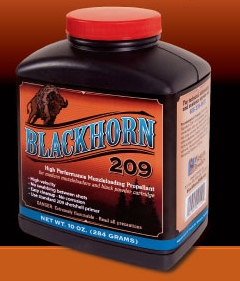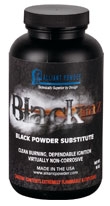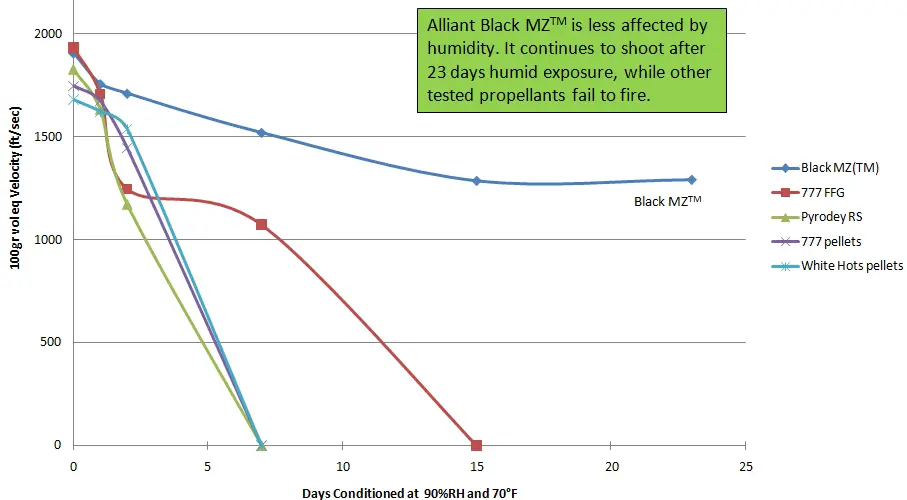


2011 – 2012 Guide to Muzzleloading Propellants
This is a brief overview of propellant powders used in muzzleloaders today. I'm not covering organic blackpowder, although it is a very consistent and accurate propellant when properly used and remains the first choice as flintlock pan powder due its easy ignition. It is availability is limited, due to its DOT classification as an explosive, and its reactivity profile is: “Black powder is usually composed of a reduced material charcoal/sulfur and an oxidizer either, potassium or sodium nitrate. These materials are physically mixed together. Black powder is sensitive to impact, friction, and sparks and generally burns as an explosive deflagration. Under certain conditions has been known to detonate.”
Organic blackpowder became obsolete in 1884, when Paul Vieille invented a gunpowder called Poudre B. For over 125 years, there have been propellants that are less corrosive, safer to manufacture, and safer to transport, use, and store. Hunting seasons themselves are a modern innovation, and it is hard to find any hunter today that does not use electricity or motorized vehicles at one time or another. Far more modern materials are in use by hunters in their clothing, eyewear, footwear, and food to name but a few areas.
Many propellant brands have come and gone, with Pyrodex and Goex Clear Shot being close to volumetric equivalents. Pyrodex remains available today, although it is more powerful than blackpowder by weight, about 30% more, when measured by volume it is close to an equivalent. Pyrodex, a synthetic propellant, was marketed as “the smokeless muzzleloading propellant” for years. It was the first truly successful propellant marketed as a “blackpowder sub” as it was classified and able to be shipped like smokeless powder.
PYRODEX
Dirty, extremely corrosive, but sufficiently consistent and widely available, it was the first truly successful, modern synthetic volumetric replacement for blackpowder. Subsequent replacements have sought to eliminate the corrosivity of Pyrodex, the smell, the swabbing between shots, and the messy clean-up. With sabots, for consistent results, you lick a patch and clean between each shot.
TRIPLE SEVEN
The first super modern, widely successful muzzleloading propellant, Triple Seven was introduced in 2001. Touted for “easy water clean up and no sulfur (rotten egg) smell!” it introduced ignition problems for some caplocks, crud rings, and frozen breechplugs as well. Nevertheless, it is high-energy compared to blackpowder and Pyrodex, gives higher velocities, and has been a successful product. It still is corrosive, but not as corrosive as Pyrodex, and readily absorbs water, up to 27% or so in independent tests. Again, with sabots, for consistent results, you lick a patch and clean between each shot.
AMERICAN PIONEER / SHOCKEY'S GOLD
With essentially no quality control and erratic velocities, Shockey's Gold and American Pioneer has been the most inconsistent propellants I've tested in recent years, and is unsuitable for muzzle loading use compared to everything else on the market. Don't waste your time with this dismal garbage.
BLACKHORN 209

Blackhorn 209, designed from scratch to be a propellant for inline muzzleloading rifles, is currently approved by CVA, Knight, Traditions, and Thompson for use in their blackpowder rifles. In the performance category, it essentially the same as Hodgdon Triple Seven from the perspective of velocity per volumetric unit.
It eliminates the crud ring, the frozen breechplugs, and the swabbing between shots. The only drawback is that it is harder to ignite than other propellants, and is best used with full-strength 209 shotshell primers in “sealed action” inline muzzleloaders. Sealed action is a bit of a misnomer, though, as breechplugs that didn't have holes in them wouldn't work. You do need an efficient breechplug, though, and that means a T/C Omega, T/C Impact, T/C Encore, or Savage 10ML-II for best results. In these rifles, and others with sufficient efficient breechplugs, it has been the best blackpowder replacement for inline muzzleloaders that I've tested and hunted with. No swabbing is required between shots.
ALLIANT BLACK MZ

New for 2011, Alliant introduces its “Black MZ.” Made by American Pioneer for Alliant, it is vastly improved in consistency by Alliant's “test every lot” quality control. This product, like Pyrodex, is essentially a blackpowder performance equivalent. The stated benefits are better moisture resistance than Pyrodex, Triple Se7en, and so forth. It is also has better, easier ignition, so it can be used in all muzzleloaders with the exception of as a pan-powder in flintlocks, as far as I know. I believe that means percussion blackpowder handguns as well. Expect a full review of Alliant Black MZ in the near future.

Those familiar with my prior articles understand that I've come to the conclusion that pellets really suck, and that working up a load cannot be properly done with pellets. As they suck moisture, are prone to cracking, and are horribly overpriced as a nasty bonus, I won't waste your time with any pellet discussion here.
Stainless steel can of course rust. While many products have been called "non-corrosive," that hardly means you shouldn't clean your firearm after using it-- all of them. Unprotected metal may quickly rust, regardless of propellant used. Exposure to moisture in the air is sufficient to corrode gun barrels.

Custom Search

